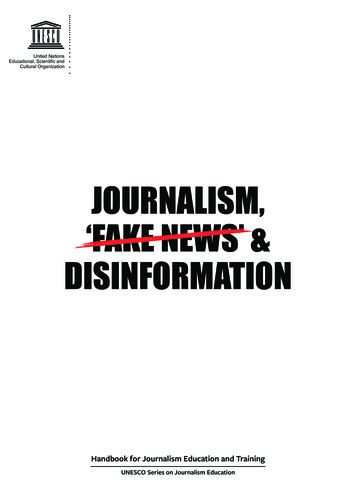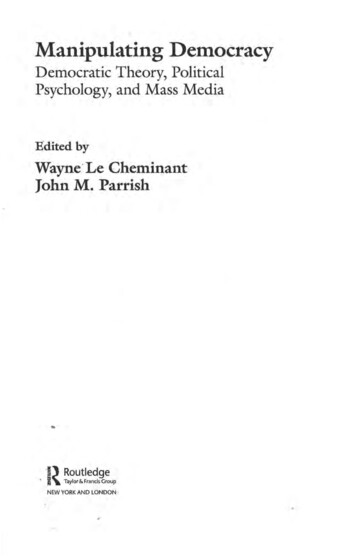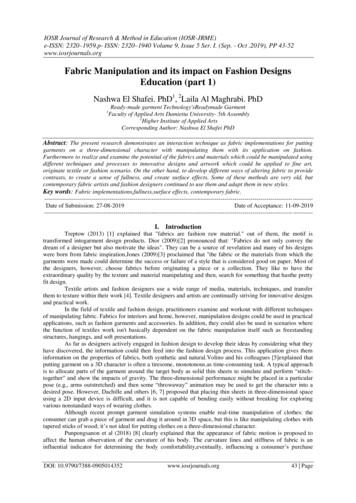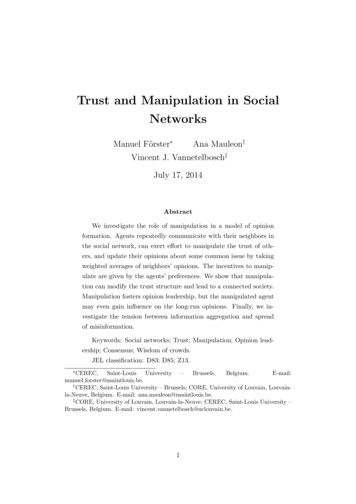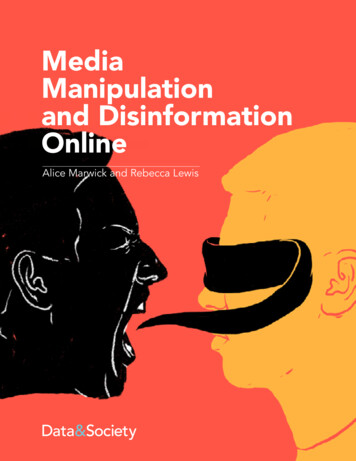
Transcription
MediaManipulationand DisinformationOnlineAlice Marwick and Rebecca Lewis
C O N TE N TSExecutive Summary. 1What Techniques Do Media Manipulators Use?. 33Understanding Media Manipulation. 2Participatory Culture. 33Who is Manipulating the Media?. 4Networks. 34Internet Trolls. 4Memes. 35Gamergaters. 7Bots. 36Hate Groups and Ideologues. 9Strategic Amplification and Framing. 38The Alt-Right. 9Why is the Media Vulnerable?. 40The Manosphere. 13Lack of Trust in Media. 40Conspiracy Theorists. 17Decline of Local News. 41Influencers. 20The Attention Economy. 42Hyper-Partisan News Outlets. 21What are the Outcomes?. 44Politicians. 21Misinformation. 44Where Do These Actors Operate Online?. 24Growing Distrust in the Media. 45Blogs and Websites. 24Further Radicalization. 45Forums and Message Boards. 24Conclusion. 47Mainstream Social Media Sites. 26Questions. 49What Motivates Media Manipulators?. 27Case Studies. 50Ideology. 27The White Student Union. 50Radicalization. 29Trump and the Star of David Image. 52Money. 31Hillary’s Health. 53Status and Attention. 31Pizzagate. 55Appendix: Cast of Characters. 57Endnotes. 60Bibliography. 83Acknowledgments. 104Data & Society Research Institutedatasociety.net
E X ECU TI VE SU MMARY Internet subcultures take advantage of the current media ecosystem tomanipulate news frames, set agendas, and propagate ideas. Far-right groups have developed techniques of “attention hacking” toincrease the visibility of their ideas through the strategic use of socialmedia, memes, and bots—as well as by targeting journalists, bloggers, andinfluencers to help spread content. The media’s dependence on social media, analytics and metrics,sensationalism, novelty over newsworthiness, and clickbait makes themvulnerable to such media manipulation. While trolls, white nationalists, men’s rights activists, gamergaters, the “altright,” and conspiracy theorists may diverge deeply in their beliefs, theyshare tactics and converge on common issues. The far-right exploits young men’s rebellion and dislike of “politicalcorrectness” to spread white supremacist thought, Islamophobia, andmisogyny through irony and knowledge of internet culture. Media manipulation may contribute to decreased trust of mainstream media,increased misinformation, and further radicalization.Data & Society Research Institutedatasociety.net1
UNDERSTANDING MEDIAMANIPULATIONIn early October 2016, Wikileaks posted a dump of 20,000 hacked emails from theGmail account of John Podesta, Hillary Clinton’s campaign chairman. Users on aninternet message board called 8chan/pol/—short for “politically incorrect”—immediately began combing through the emails looking for damaging material aboutHillary Clinton. Using social media, they spread allegations that George Soros wasfunding liberal protesters to disrupt Trump rallies, that a vast ring of pedophileswas operating out of a Chevy Chase, Maryland pizza parlor, and that Clinton hada secret desire to assassinate Julian Assange. Despite the spurious, even fantastical nature of such allegations, they spread through social media to far-right blogsand eventually to the mainstream media. As one 8chan poster wrote: “The mediaisn’t doing their job. With thousands of emails released, the only things they’vereported on even marginally has been what WE’VE dug up. They literally can’t bebothered to do any digging at all.”In the months leading up to the 2016 U.S. election, a number of subcultural groupswho organize online made a concerted effort to manipulate the existing media infrastructure to promote pro-Trump, populist messages. These messages spread throughmemes shared on blogs and Facebook, through Twitter bots, through YouTubechannels, and even to the Twitter account of Trump himself—and were propagatedby a far-right hyper-partisan press rooted in conspiracy theories and disinformation.They influenced the agenda of mainstream news sources like cable television, TheWashington Post, and the New York Times, which covered Clinton conspiracy theories more than Trump’s alleged sexual assaults and ties to Russia.1Many of these far-right online groups consider themselves members of a new “altright” movement, and have even claimed credit for “meme-ing Trump into theWhite House.”2 Provocateurs like Milo Yiannopolous have explicitly linked the altright to the methods of online “trolling,” and the underground imageboards 4chanand 8chan:The alt-right is a movement born out of the youthful, subversive, undergroundedges of the internet. 4chan and 8chan are hubs of alt-right activity. For years,members of these forums – political and non-political – have delighted in attention-grabbing, juvenile pranks. Long before the alt-right, 4channers turnedtrolling the national media into an in-house sport. 3Data & Society Research Institutedatasociety.net2
UND E R S TAND I NG ME D I A M A N I PU LATI ONHowever, scholars Whitney Phillips, Jessica Beyer, and Gabriella Coleman areskeptical of the narrative that 4chan and the alt-right were the critical force underwriting Trump’s success, arguing that this explanation minimizes broader socio-cultural trends4 and gives too much power to a very small number of people.5 There isstill a great deal of ambiguity around the outcome of the election and why themajority of experts and predictions did not foresee Trump’s win. Given this confusion, the alt-right was happy to take credit. However, determining the lines ofcritical influence is too complicated to conclude so tidily. This piece attempts to askwhat those lines of influence—media manipulation—actually look like.In this report, we delve into how variousTaking advantage of the opportunity internet subcultures—sometimes summathe internet presents for collaboration, rized as the “alt-right,” but more accuratelycommunication, and peer production, these an amalgam of conspiracy theorists, techgroups target vulnerabilities in the news no-libertarians, white nationalists, Men’smedia ecosystem to increase the visibility Rights advocates, trolls, anti-feminists,of and audience for their messages. anti-immigration activists, and bored youngpeople—leverage both the techniques of6participatory culture and the affordances of social media to spread their variousbeliefs. Taking advantage of the opportunity the internet presents for collaboration, communication, and peer production, these groups target vulnerabilities inthe news media ecosystem to increase the visibility of and audience for their messages. While such subcultures are diverse, they generally package themselves asanti-establishment in their reaction against multiculturalism and globalism, whilepromoting racist, anti-feminist, and anti-Semitic ideologies. We use the term “farright” to characterize these players collectively, though many of these communitiesresist identification with the term.To understand the context for media manipulation and disinformation, we must godown several rabbit holes. A variety of different movements, moments, and developments have coincided to shape the contemporary media landscape. While it isimpossible to ascertain its impact on the U.S. election, it is important to examinethe relationship between internet subcultures and narratives put forward by various media organizations. What follows is an attempt to parse out and create definition around the moving pieces of this loosely connected network—namely: whois involved, their motivations, and where they operate online. This mapping is byno means comprehensive, and the categories identified here are not always distinctfrom each other.Data & Society Research Institutedatasociety.net3
WHO IS MANIPULATINGTHE MEDIA?The term “alt-right” is a neologism that puts a fresh coat of paint on some verylong-standing racist and misogynist ideas. It can be convenient to use the term as acatch-all for the groups involved in far-right media manipulation, but while manyof the groups we identify in this report can be characterized as such, others cannot.Many of these segments have their own agendas, but, as this document details,share similar tactics. Furthermore, some participants in this ecosystem are organized by their beliefs (like Men’s Rights Activists), while others are organized byparticular media or platforms (such as individual blogs and podcasts). Thus, thelines between these groups are always blurry and uneven.I NTERNET TROL L S“Trolling” developed in tandem with the internet.7 Initially, the term “troll”described those who deliberately baited people to elicit an emotional response.Early trolls posted inflammatory messages on Usenet groups in an attempt to catchnewbies in well-worn arguments.8 During the ‘00s, this motivation became knownas the “lulz”: finding humor (or LOLs) in sowing discord and causing reactions.Trolls have a history of manipulating the media to call out hypocrisies and hysterias, learning early on how to target public figures and organizations to amplifytheir efforts through mainstream media.9 They have often claimed to be apoliticaland explained their use of shocking (often racist or sexist) imagery as merely aconvenient tool to offend others.Trolling can refer to relatively innocuous pranks, but it can also take the form ofmore serious behaviors. Trolling can include “mischievous activities where theintent is not necessarily to cause distress”10 or it can seek to “ruin the reputation ofindividuals and organizations and reveal embarrassing or personal information.”11In practice, however, trolling has grown to serve as an umbrella term whichencompasses a wide variety of asocial internet behaviors.For the purposes of our discussion, we will focus on one type of trolling prevalenton the anonymous imageboard 4chan/b/ in the mid-2000s. Amongst the diverseecosystem of the contemporary media landscape, 4chan is both relatively obscureand disproportionately influential. The site is simple. Posts consist only of imagesand text posted anonymously, which disappear very quickly, often after only a fewhours.12 Despite this, 4chan is not a free-for-all; each sub-board has a designatedtopic and specific norms which are strictly enforced by other users.13 (4chan’spopularity has given rise to a variety of other “chans” including 8chan, 2chan, andData & Society Research Institutedatasociety.net4
W H O I S M ANI P UL AT I N G THE M EDI A ?Wizardchan; see the “Forums and Message Boards” section below for more.)Most of 4chan’s boards are dedicated to topics that would be at home on anyonline message board—sports, music, fitness. But 4chan’s most notorious boardis /b/. Originally reserved for “random” content, in practice /b/ is home to deliberately offensive language and pictures—a constant, ever-changing stream of racialand sexual epithets, porn, and grisly images chosen precisely for their transgressivenature.14 In addition to producing a hyper-exaggerated visual discourse for users of/b/, such images also function as a way to shock and deter outsiders from cominginto the community.The style of trolling developed by 4chan’s /b/ users can be characterized byfour properties that are key to understanding the current practices of mediamanipulation:15 The use of deliberately offensive speech Antipathy toward sensationalism in the mainstream media The desire to create emotional impact in targets The preservation of ambiguity (Poe’s Law: “Without a clear indication of theauthor’s intent, it is difficult or impossible to tell the difference between anexpression of sincere extremism and a parody of extremism.”16)Offensive speech. Hate speech violates sensibilities, and people take it very seriously, making it exactly the type of moral boundary that 4chan users love totransgress. By its very nature, hate speech is directed towards racial and sexualminorities and women, and 4chan presumes that everyone is white and male untilproven otherwise.17 4chan participants usually dismiss their cavalier use of “fag” or“n*****” as ironically funny, or as a way to maintain boundaries: people offendedby such speech will stay away from spaces that use it, as intended. This practicealso dovetails with an extremist commitment to “free speech,” which is stronglytied to the polarized discourse against political correctness.Trolling and the mainstream media.Trolling the mainstream media to exploit its Internet scholar Whitney Phillips arguespenchants for spectacle, novelty, and poignancy that much trolling is a reaction to theis not only a favored pastime for trolls but is mainstream media, particularly the typeoften used as a justification for trolling behavior. of tragedy-of-the-week moral panic perpetrated by talk shows and cable news.She provides an illustrative example. A 4chan user trolled message boards run bythe Oprah show posing as a pedophile, with a ridiculous, over-the-top story ofhaving “over 9000” penises with which to rape children. (The phrase “over 9000”Data & Society Research Institutedatasociety.net5
W H O I S M ANI P UL AT I N G THE M EDI A ?comes from 90’s anime show Dragon Ball Z and was a popular in-joke on 4chanat the time.) Oprah’s team fell for the story, and Oprah herself warned her viewersthat a known pedophile network “has over 9000 penises and they’re all raping children.”18 Trolling the mainstream media to exploit its penchants for spectacle,novelty, and poignancy is not only a favored pastime for trolls but is often used asa justification for trolling behavior. This enables trolls to maintain a quasi-moralargument that, by trolling, they are exposing the hypocrisy, ignorance, and stupidity of the mainstream media.Emotional affect. The goal of trolling is engendering negative emotional responsesin its targets, and as such, requires a certain lack of empathy. Sometimes trollsdistance themselves from their victims by constructing arguments for why the victims deserve the abuse. This is the case with many Facebook trolls who post gorypictures and silly jokes to the memorial pages set up for deceased teenagers, justifying this as a reaction to sanctimonious “grief tourists” who pretend to care aboutpeople they didn’t know.19 In other instances, trolls scoff that their targets care toomuch about the internet, which, after all, is not “real life.” The ability to create thisresponse is discussed as if a game, with trolls working together to “score points”—an indignant, angry, or tearful response is the ultimate goal.Poe’s Law. A very successful troll plays with ambiguity in such a way that theaudience is never quite sure whether or not they are serious. This is a key featureof many subcultural spaces, where racist speech and content is bandied aroundin such a way that it can be read either as the trolling of political correctness oras genuine racism.20 Determining intent is often impossible, especially given thatparticipants are most often anonymous.GAMERG ATERSIn the last decade, the community of self-identifying “gamers,” organized largelyaround their consumption of videos games, has been newly politicized. Althoughmany male geeks are privileged in terms of race and gender, the geek identity haslong had a reputation for suffering forms of social oppression.21 They may havebeen bullied by a “Chad” (internet slang for the stereotypical tanned, buff “bro”)or had a difficult time pursuing romantic relationships. They may be unemployedand uneducated. This is reflected in some of the terms they use to describe themselves—as “betas” (non-alpha, weak, compromised, fragile, or pathetic men) or“NEETs” (Not Engaged in Employment or Training, a term that originated in areport by the Social Exclusion Task Force of the UK government). Thus, they arevery resistant to discussions of white privilege and male privilege as they do notsee themselves as privileged, but as disadvantaged.22Data & Society Research Institutedatasociety.net7
W H O I S M ANI P UL AT I N G THE M EDI A ?This is best demonstrated by Gamergate, an online movement that used the strategies and tactics of participatory culture to target feminist media critics and gamedevelopers. Gamergate’s origins are complicated. Briefly, software developer ZoeQuinn became the target of an organized brigade after her ex-boyfriend publisheda 10,000-word screed about her on his“Gamergater” has become shorthand for a blog. He claimed that Quinn lied to him,particular kind of geek masculinity that feels cheated on him, and, most damagingly,victimized and disenfranchised by mainstream slept with a video game reviewer to getsociety, particularly popular feminism. favorable coverage for her game Depression Quest. While these claims werequestionable, they led to significant harassment of Quinn under the pretext ofreforming “ethics in video game journalism.”“Gamergater” has become shorthand for a particular kind of geek masculinity thatfeels victimized and disenfranchised by mainstream society, particularly popularfeminism.23 When feminist media critics like Anita Sarkeesian criticize the portrayalof women in video games, this group claims their culture is being attacked and freespeech is being infringed upon, opening an opportunity to interpret feminist critiqueas the systemic oppression of geek identity. These individuals—who are often, butnot always, young white men—see gaming culture, and nerd/geek culture overall, asa refuge under siege from “political correctness” and “social justice warriors.”24IRC chat logs have since revealed that a group of 4chan users strategically engineered Gamergate to foster support among a diverse array of constituents,including Men’s Rights Activists, journalists, gamers, and conservative politicalcommentators in the service of harassment.25 By contriving to have these groupswork together, the manipulators were able to amplify their harassment of Quinnand other feminist critics of video games such as Anita Sarkeesian and BriannaWu.26 This harassment took place primarily on Twitter with the hashtag #gamergate, which was used to insult feminists and women in the video game industryfar more than it was used to discuss the ethics of video game reviews.27 Moreover,trolls with no interest in video games used the hashtag to create more chaos, whichwas blamed on Gamergate.28Although the activity around Gamergate has largely dissolved, it was nonethelessa crucial moment for the development of online subcultural tactics, strategies, andskills. In particular, three tactics used during Gamergate can help us understandthe subsequent emergence of the alt-right: Organized brigades Networked and agile groups Retrograde populismData & Society Research Institutedatasociety.net8
W H O I S M ANI P UL AT I N G THE M EDI A ?Organized brigades. Sarkeesian refers to these groups as “cybermobs”—collectives which engage in a cooperative competition to increase harm to their victims,reinforcing social dominance over marginalized groups.29 People work together tolearn personal information about their targets. They gain status in their community as they escalate the harassment. In this way, online harassment, like trolling,becomes informally gamified.Networked groups. Gamergate shows that groups of people with all sorts of ideological conflicts—from white supremacists to libertarians to video game fans toMen’s Rights Activists—can and will come together around a common cause andjust as quickly disappear. These groups are networked and agile.Retrograde populism. Gamergate participants asserted that feminism—and progressive causes in general—are trying to stifle free speech, one of their most cherished values.30 They are reacting to what they see as the domination of the worldby global multiculturalism and the rise of popular feminism. This is a retrogradepopulist ideology which reacts violently to suggestions of white male privilege, isdirectly linked to the language of the Men’s Rights Movement, and is also presentin the messaging of the alt-right.31Ultimately, Gamergate demonstrated the refinement of a variety of techniques ofgamified public harassment—including doxing (publishing personal informationonline), revenge porn (spreading intimate photos beyond their intended recipients), social shaming, and intimidation. It also provides insight into gender as a keyrallying point for a range of online subcultures. Moreover, it set the conditions forthe rise of the alt-right. Several of the most active promoters of Gamergate are nowcore alt-right figures, including Milo Yiannopolous, Vox Day (Theodore Beale),Matt Forney (of Men’s Rights blog Return of Kings), and Andrew “weev” Auernheimer. Gamergate’s success at mobilizing gamers to push an ideological agendaindicates the fruitfulness of radicalizing interest-based communities.HATE GROU PS A ND IDEO LO GUESWhite supremacist and white nationalist groups have long used the web in thehopes of recruiting new members, but the emergence of the self-styled “alt-right”has increased their visibility.32 The “manosphere” is a loose collection of blogs andforums devoted to men’s rights, sexual strategy, and misogyny. Both groups may usetrolling tactics to draw attention to their causes, or may present themselves as moreserious and scholarly.T H E ALT- R I GH TThe term “alt-right” was coined by Richard Spencer in 2008 to describe right-wingpolitical views at odds with the conservative establishment.33 Spencer, a highly-edData & Society Research Institutedatasociety.net9
W H O I S M ANI P UL AT I N G THE M EDI A ?ucated prep school graduate (and Duke PhD dropout) went on to found the publication AlternativeRight.com and became head of the National Policy Institute(NPI), a white nationalist think tank.34By re-branding “white nationalism” or His various publications and affiliated“white supremacy” as “the alt-right,” these groups (VDARE.com; American Renaisgroups played on the media’s fascination with sance; The Occidental Quarterly; Countnovelty to give their ideas mass exposure. er-Currents Publishing) were an attempt tointellectualize white supremacist ideology(NPI’s Radix magazine looks more-or-less like a left-wing academic journal andpublishes what it calls “critical theory”).The term “alt-right,” however, fulfilled several other goals. As a neologism, itallowed ideas long seen as unacceptable to mainstream media to seep into publicdiscourse.35 In political punditry, this is called “opening the Overton window,”or expanding the range of what is politically acceptable.36 By re-branding “whitenationalism” or “white supremacy” as “the alt-right,” these groups played on themedia’s fascination with novelty to give their ideas mass exposure. The anti-Semiticblog The Daily Stormer pioneered a number of the alt-right’s aesthetic elements,many of which cribbed directly from chan culture: memes, 80s sci-fi, Italo-disco/synthpop music, and, as founder Andrew Anglin puts it, “Non-ironic Nazismmasquerading as ironic Nazism.”37 Thus, white nationalism was re-engineered toappeal to millennials.The term “alt-right” is accommodatingly imprecise. On one hand, it describes anaggressive trolling culture present in /b/ and /pol/ that loathes establishment liberalism and conservatism, embraces irony and in-jokes, and uses extreme speech toprovoke anger in others.38 On the other, it denotes a loosely affiliated aggregationof blogs, forums, podcasts, and Twitter personalities united by a hatred of liberalism, feminism, and multiculturalism.39 Per Poe’s Law, attempting to determinewhich of these people are “serious” and which are “ironic” is impossible. Evenamong those who do seem ideologically committed—people generating thousandsof words of blog posts per week discussing, for instance, the impact of immigrationon Europe—the group is diverse in its beliefs and marked by constant infightingand squabbling. People who the mainstream media views as “leaders” of the altright, like Richard Spencer and Milo Yiannopolous, are by no means universallyembraced or even accepted. Similarly, some alt-right media (like the Daily Stormeror Fash the Nation) are explicit in their promotion of anti-Semitism and neo-Nazism, while others condemn it.40 Attempting to form coherence out of this looseaggregate is very difficult. Ambiguity is, itself, a strategy; it allows participants todissociate themselves with particularly unappetizing elements while still promoting the overall movement.41Data & Society Research Institutedatasociety.net11
W H O I S M ANI P UL AT I N G THE M EDI A ?Overall, the alt-right is characterized by a deeply ironic, self-referential culturein which anti-Semitism, occult ties, and Nazi imagery can be explained either asentirely sincere or completely tongue-in-cheek. Many alt-right advocates vociferously argue against labels of racism or Neo-Nazism. Allum Bokhari and Milo Yiannopolous explained, “Are [8chan/pol users] actually bigots? No more than deathmetal devotees in the 80s were actually Satanists. For them, it’s simply a means tofluster their grandparents.”42 This perspective holds that, for 8chan participants,defending Hitler is simply a strategic move to annoy people and deter outsidersfrom taking part. However, this description is disingenuous. While these spaces arediverse, white nationalism (if not white supremacy) is a consistent subcurrent inalt-right communities. Many alt-right actions—propagating Nazi symbols, usingracial epithets, or spreading anti-immigrant ideology—support white nationalistideologies. Whether undertaken sincerely or ironically, the outcome is the same.43There seems to be a coherent willingness to act in support of white nationalism,even in the parts of the alt-right that do not explicitly adopt or claim it as an ideological commitment.In a perceptive essay, M. Ambedkar describes the unifying aesthetics of the alt-right: “The cult of tradition which idealizes a primordial past (think Make AmericaGreat Again, or Mussolini’s call to build a new Rome, a call recently echoedby White Nationalist Richard Spencer). fear of difference, whether difference be sexual, gendered, religious, or racial. a cult of masculinity that tends to manifest itself in an obsession with sexualpolitics (refer to online pick-up artistry and the heteronormative gender rolesembodied in the nuclear family.) a hostility towards parliamentary politics and criticality. a belief in permanent warfare and a corresponding cult of action for action’ssake. a worship of technology, not in the manner of an Enlightenment-esqueworship of reason, but faith in technology to conquer and to reaffirminegalitarianism.”44The “cult of tradition” surfaces in fringe movements associated with the alt-rightthat advocate a return to an imaginary past where men were men, immigrationwas limited, and so forth. (Many figures in the contemporary Men’s Rights Movement, like Jack Donovan, who advocates for homosocial tribalism, and Daryush“Roosh” Valizadeh of the blog Return of Kings, also believe in a return to what theysee as a pre-modern masculinity.) The blogger Mencius Moldbug, originator ofthe “Dark Enlightenment” movement, is a software developer and former libertarData & Society Research Institutedatasociety.net12
W H O I S M ANI P UL AT I N G THE M EDI A ?ian who believed that liberal democracy was, essentially, incompatible with freedom and the free market, instead advocating for a return to monarchic feudalism.(His popular, now defunct, blog, primarWhile these ideas are on the fringe, they ily consists of very long posts aboutenjoy currency even among some powerful political theory.)45players who draw parallels between meritocraticfiefdoms and technology startups.Such neoreactionary politics workalongside Silicon Valley politics of technolibertarians and the Californian Ideology, a mix of objectivism and technological determinism.46 While these ideas are on the fringe, they enjoy currency evenamong some powerful players who draw parallels between meritocratic fiefdomsand technology startups. For instance
Media manipulation may contribute to decreased trust of mainstream media, increased misinformation, and further radicalization. EXECUTIVE SUMMARY. Data Soiet Resear Institute datasoietnet 2 UNDERSTANDING MEDIA MANIPULATION In early October 2016,
